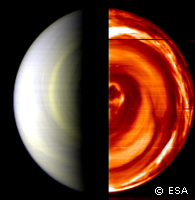Venus Express settles down to business
The European Space Agency (ESA)'s Venus Express probe has moved into an operational orbit around its target planet, where it can shortly begin work. The probe arrived at Venus on 11 April, and has since made progressively tighter orbits of the planet. The orbit became 'stable' on 7 May. When the probe made its initial orbit on 11 April, it drew an elliptical path around the planet. The probe varied its height from 400 km at its closest point (pericentre) to Venus and 330,000 km at its furthest point (apocentre). The probe has used its array of thrusters and its main engine to reduce the height of both the pericentre and apocentre in 16 subsequent orbits. 'Firing at apocentre allows the spacecraft to control the altitude of the next pericentre, while firing at the pericentre controls the altitude of the following apocentre,' said Andrea Accomazzo, Spacecraft Operations Manager at ESOC, the European Space Operations Centre. 'It is through this series of operations that we reached the final orbit last Sunday, about one orbital revolution after the last 'pericentre change manoeuvre' on Saturday 6 May.' The probe now orbits every 24 hours, at a height of 250 km at pericentre and 66,000 km at apocentre, around the poles of Venus. From this height the probe will begin to examine the planet. 'This is the orbit designed to perform the best possible observations of Venus, given the scientific objectives of the mission. These include global observations of the Venusian atmosphere, of the surface characteristics and of the interaction of the planetary environment with the solar wind,' according to Håkan Svedhem, Venus Express Project Scientist. 'It allows detailed high resolution observations near the pericentre and the North Pole, and it lets us study the very little explored region around the South Pole for long durations at a medium scale,' he said. However, work will not start quite yet. 'The spacecraft instruments are now being switched on one-by-one for detailed checking, which we will continue until mid-May. Then we will operate them all together or in groups,' said Don McCoy, Venus Express Project Manager. 'This allows simultaneous observations of phenomena to be tested, to be ready when Venus Express' nominal science phase begins on 4 June 2006,' he said. There are high hopes for the mission. Test pictures with the VMC (Venus Monitoring Camera) and VIRTIS (Visible and Infrared Thermal Imaging Spectrometer) have already provided ESA with the first ever images of the planet's south pole, revealing a huge cloud vortex. Further experiments will reveal a great deal more about the planet, in many ways Earth's twin - it is a similar size, age and distance from the Sun - but which has evolved very differently. Many experts believe that Venus may have once held oceans, but if so, these have long since evaporated. The planet is now shrouded in thick, toxic clouds that rotate more quickly than the planet- another quirk that the mission aims to resolve. Scientists also hope to use Venus as a model for climate change on Earth.



